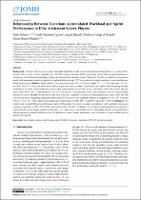Por favor, use este identificador para citar o enlazar este ítem:
https://repositorio.usj.es/handle/123456789/958
Registro completo de metadatos
| Campo DC | Valor | Lengua/Idioma |
|---|---|---|
| dc.contributor.author | Nobari, Hadi | - |
| dc.contributor.author | Ceylan, Halil Ibrahim | - |
| dc.contributor.author | Khani, Soghra | - |
| dc.contributor.author | Ozturk, Mehmet Ertugrul | - |
| dc.contributor.author | Mainer Pardos, Elena | - |
| dc.date.accessioned | 2023-08-03T07:14:41Z | - |
| dc.date.available | 2023-08-03T07:14:41Z | - |
| dc.date.issued | 2022-07-13 | - |
| dc.identifier.citation | Hadi Nobari, Halil İbrahim Ceylan, Saeed Khani, Mehmet Ertuğrul Öztürk, Elena Mainer-Pardos. Relationship Between Variations Accumulated Workload and Sprint Performance in Elite Adolescent Soccer Players. J. Mens. Health 2022, 18(7), 157. https://doi.org/10.31083/j.jomh1807157 | en_US |
| dc.identifier.issn | 1875-6859 | en_US |
| dc.identifier.uri | https://repositorio.usj.es/handle/123456789/958 | - |
| dc.description.abstract | Background: The aim of this study is to analyze the relationship between the accumulated training load parameters (i.e., acute (AWL), chronic (CWL), acute: chronic workload ratio (ACWR), training monotony (TM), and training strain (TS)) and sprint performance variations in elite adolescent soccer players, taking into account the maturation status of the players. Besides, we aimed to use regression models with mentioned parameters, sprint level, and peak height velocity (PHV) as predictors to explain variations in sprint performance during the in-season. Methods: Twenty-seven U16 soccer players (age: 15.5 +-} 0.2 years, height: 171 +-} 7.3 cm, body mass: 59 +-} 6.1 cm, PHV: 14.4 +- 0.7) from one elite soccer national league club were evaluated. In this study was a cohort with monitoring the daily workload for 15 weeks in the competition season: early-season (EaS) weeks (w) W1 to W5; mid-season (MiS) W6 to W10; and endseason (EnS) W11 to W15. Anthropometric and PHV were assessed at the beginning of the season and sprint test was assessed before and after the season. Results: Results showed that there were some significant variations in workload parameters (sprint, AWL and TM) over a soccer season. Regarding comparisons between EaS vs. EnS, there were significant differences in Sprint (p≤0.01; ES: –0.28) and CWL (p ≤ 0.01; ES: –0.80). Sprint performance can be estimated by ACWR, TM, TS and PHV values (R2 = 0.65). Conclusions: The present study revealed that sprint performance improved throughout the season in young soccer players, with significant intra-season variations, especially in CWL and ACWR load variables (Eas and Mid). In addition, it was observed that maturation did not have a significant effect on the change in sprint performance. This study clearly showed that there is a relationship between sprint performance and accumulated workload variables and that the significant change in sprint performance can be explained by load variables such as AWCR, TM, and TS. | en_US |
| dc.format.extent | 11 p. | en_US |
| dc.format.mimetype | application/pdf | en_US |
| dc.language.iso | eng | en_US |
| dc.publisher | MRE PRESS | en_US |
| dc.rights | Attribution-NonCommercial-NoDerivatives 4.0 Internacional | * |
| dc.rights.uri | http://creativecommons.org/licenses/by-nc-nd/4.0/ | * |
| dc.subject | Linear sprint | en_US |
| dc.subject | Running speed | en_US |
| dc.subject | Training strain | en_US |
| dc.subject | Football | en_US |
| dc.subject | In-season | en_US |
| dc.subject | Maturation | en_US |
| dc.subject | ACWLR | en_US |
| dc.subject | Training monotony | en_US |
| dc.title | Relationship Between Variations Accumulated Workload and Sprint Performance in Elite Adolescent Soccer Players | en_US |
| dc.type | info:eu-repo/semantics/article | en_US |
| dc.identifier.doi | https://doi.org/10.31083/j.jomh1807157 | en_US |
| dc.rights.accessrights | info:eu-repo/semantics/openAccess | en_US |
| Aparece en las colecciones: | Artículos de revistas | |
Ficheros en este ítem:
| Fichero | Descripción | Tamaño | Formato | |
|---|---|---|---|---|
| Relationship Between Variations Accumulated Workload and Sprint Performance in Elite Adolescent Soccer Players.pdf | 2,54 MB | Adobe PDF |  Visualizar/Abrir |
Este ítem está sujeto a una licencia Creative Commons Licencia Creative Commons

